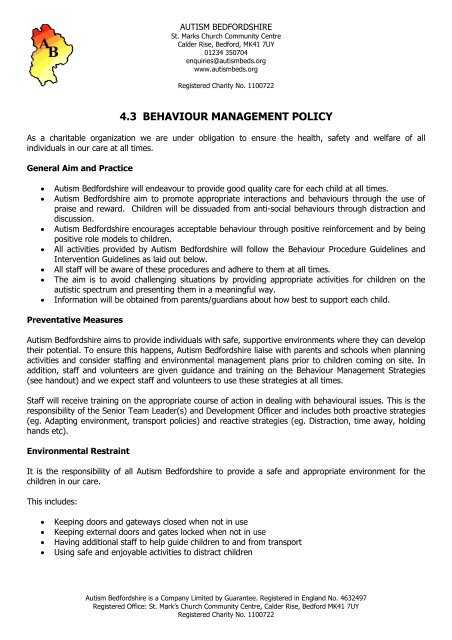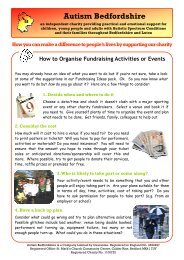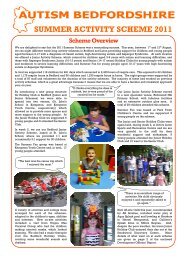4.3 BEHAVIOUR MANAGEMENT POLICY - Autism Bedfordshire
4.3 BEHAVIOUR MANAGEMENT POLICY - Autism Bedfordshire
4.3 BEHAVIOUR MANAGEMENT POLICY - Autism Bedfordshire
You also want an ePaper? Increase the reach of your titles
YUMPU automatically turns print PDFs into web optimized ePapers that Google loves.
AUTISM BEDFORDSHIRESt. Marks Church Community CentreCalder Rise, Bedford, MK41 7UY01234 350704enquiries@autismbeds.orgwww.autismbeds.orgRegistered Charity No. 1100722<strong>4.3</strong> <strong>BEHAVIOUR</strong> <strong>MANAGEMENT</strong> <strong>POLICY</strong>As a charitable organization we are under obligation to ensure the health, safety and welfare of allindividuals in our care at all times.General Aim and Practice• <strong>Autism</strong> <strong>Bedfordshire</strong> will endeavour to provide good quality care for each child at all times.• <strong>Autism</strong> <strong>Bedfordshire</strong> aim to promote appropriate interactions and behaviours through the use ofpraise and reward. Children will be dissuaded from anti-social behaviours through distraction anddiscussion.• <strong>Autism</strong> <strong>Bedfordshire</strong> encourages acceptable behaviour through positive reinforcement and by beingpositive role models to children.• All activities provided by <strong>Autism</strong> <strong>Bedfordshire</strong> will follow the Behaviour Procedure Guidelines andIntervention Guidelines as laid out below.• All staff will be aware of these procedures and adhere to them at all times.• The aim is to avoid challenging situations by providing appropriate activities for children on theautistic spectrum and presenting them in a meaningful way.• Information will be obtained from parents/guardians about how best to support each child.Preventative Measures<strong>Autism</strong> <strong>Bedfordshire</strong> aims to provide individuals with safe, supportive environments where they can developtheir potential. To ensure this happens, <strong>Autism</strong> <strong>Bedfordshire</strong> liaise with parents and schools when planningactivities and consider staffing and environmental management plans prior to children coming on site. Inaddition, staff and volunteers are given guidance and training on the Behaviour Management Strategies(see handout) and we expect staff and volunteers to use these strategies at all times.Staff will receive training on the appropriate course of action in dealing with behavioural issues. This is theresponsibility of the Senior Team Leader(s) and Development Officer and includes both proactive strategies(eg. Adapting environment, transport policies) and reactive strategies (eg. Distraction, time away, holdinghands etc).Environmental RestraintIt is the responsibility of all <strong>Autism</strong> <strong>Bedfordshire</strong> to provide a safe and appropriate environment for thechildren in our care.This includes:• Keeping doors and gateways closed when not in use• Keeping external doors and gates locked when not in use• Having additional staff to help guide children to and from transport• Using safe and enjoyable activities to distract children<strong>Autism</strong> <strong>Bedfordshire</strong> is a Company Limited by Guarantee. Registered in England No. 4632497Registered Office: St. Mark’s Church Community Centre, Calder Rise, Bedford MK41 7UYRegistered Charity No. 1100722
Response to Challenging Behaviour2Physical Restraint• It would be negligent to allow a child to place themselves or others at risk of harm• Physical restraint needs to be avoided wherever possible and only used as a last resort. Othermethods of managing crises must be attempted first.Response ProcedureIn the event whereby an individual is highly likely to cause significant injury to themselves or others thenthe Senior Team Leader and Team Leader(s) should, as far as is practical, carry out the following:• Isolate the situation by instructing staff and volunteers to guide children, young people and adultsaway from the immediate area.• Offer the child an alternative activity, place to play or person supporting them. <strong>Autism</strong> <strong>Bedfordshire</strong>recognise that challenging behaviour is rarely personal but that sometimes a change in staffing canhelp the child to re-settle quickly.• Limit the potential for physical injury by removing moveable objects from the immediate area.• Control the environment by limiting additional stimulus that may exacerbate the situation.• Implement approved <strong>Autism</strong> <strong>Bedfordshire</strong>’s Behaviour Management Strategies.• Report all incidents to the Development Officer.If the situation is unable to be resolved by the Senior Team Leader, Team Leader(s) in line with <strong>Autism</strong><strong>Bedfordshire</strong>’s Policies and Procedures it will be necessary to request the presence of the individual’semergency contacts either to resolve the situation or to remove the individual from site. If the individual’semergency contacts are not able to attend then it may be necessary to follow the left child policy to ensurethe health, safety and welfare of all involved.The following should be carried out immediately following any serious incident:Reporting• A detailed account of the incident and the events preceding it must be recorded in theAccident/Incident book.• This must include witness statements, details of the surrounding environment, physical injuries, andany factors that may have contributed to the incident taking place.• The Chair of <strong>Autism</strong> <strong>Bedfordshire</strong> will be informed of any recorded incidents, and subsequentactions taken by <strong>Autism</strong> <strong>Bedfordshire</strong>.Debrief• The incident will be discussed in the whole team debrief at the end of the session.• <strong>Autism</strong> <strong>Bedfordshire</strong> will arrange a meeting between all staff and volunteers involved to discuss theincident, to determine what steps are necessary, and to provide support where required.• <strong>Autism</strong> <strong>Bedfordshire</strong> is committed to working with parents to ensure the best outcomes for childrenin their care. Parents will be informed of any behaviour management incidents and theDevelopment Officer and/or Team Leader(s) will explore with the parent the reason for thebehaviour and how the behaviour will be managed in the future. This will assist the parent and the<strong>Autism</strong> <strong>Bedfordshire</strong> team to maintain a consistent approach to managing the behaviour.Further ActionsOn occasion, <strong>Autism</strong> <strong>Bedfordshire</strong> may be unable to provide adequate and appropriate support for thechild, which could lead to that child or others being harmed in any way. In these cases <strong>Autism</strong> <strong>Bedfordshire</strong>would endeavour to find alternative methods of support for this child outside this group.
3Where behaviour is deemed persistently challenging in such a way that it is affecting the enjoyment ofothers attending the scheme, causing other members to leave, or the staff and volunteers are notexperienced in dealing with the behaviour presented, the following steps should be taken:• Representatives of <strong>Autism</strong> <strong>Bedfordshire</strong> will meet to discuss the issue and see if steps could betaken to improve the situation and provide more support.• The parent will be informed and invited to a meeting to address the problem.• New strategies will be agreed and put into place.• If the behaviour continues in such a way that it jeopardises the safe and effective running of thescheme, <strong>Autism</strong> <strong>Bedfordshire</strong> may feel unable to continue to provide support on the scheme. Inthese instances we will discuss with the family and referrer about alternative support available.<strong>Autism</strong> <strong>Bedfordshire</strong> believe that children, young people and adults flourish best in an ordered environmentin which everyone knows what is expected of them and children are free to develop their play and learningwithout fear of being hurt or hindered by anyone else. We aim to encourage children to develop selfdisciplineand self-esteem in an atmosphere of mutual respect and encouragement.





